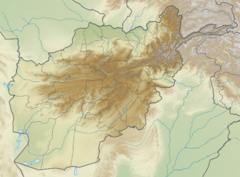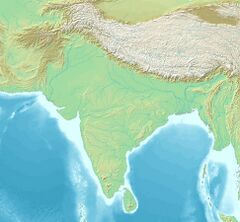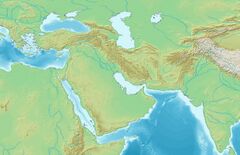Biology:Gardez Ganesha
| Gardez Ganesha | |
|---|---|
 | |
| Material | Marble |
| Size | 24 inches high x 14 inches wide[1] |
| Created | mid-8th century CE |
| Discovered | Gardez [ ⚑ ] : 34°31′31″N 69°10′42″E / 34.525278°N 69.178333°E |
| Present location | Dargha Pir Rattan Nath temple, Kabul |
The Gardez Ganesha is a statue of the Hindu god Ganesha, discovered in Gardez, near Kabul in Afghanistan. It is considered as "a typical product of the Indo-Afghan school".[1] It was dedicated by a king named Khingal.
Temporality
D.C. Sircar has dated the statue to the 6th-7th century CE, and more precisely 7th century CE based on the paleography of the inscription on its base.[1] Some authors have attributed the statue to the transitional period between Kushan art to Gupta art, to the 5th or even 4th century CE.[1] The statue of Ganesha from Gardez is now attributed to the period of Turk Shahis in the 7-8th century CE, rather than to their successors the Hindu Shahis (9th-10th century) as formerly suggested.[2] The datation is essentially based on stylistic analysis, as the displays great iconographical and stylistic similarities with the works of the Buddhist monastery of Fondukistan, which is also dated to the same period.[2]
The statue of Ganesha is also considered as contemporary to the famous Hindu statue of Surya in tunic and boots discovered in Khair Khaneh near Kabul, also attributed to the Turk Shahis in the 7-8th century CE.[2][3] Archaeologically, the construction of the Khair Khaneh temple itself is now dated to 608-630 CE, at the beginning of the Turk Shahis period.[4] Brahmanism seems to have flourished to some extent under the Turk Shahis, who were primarily supporters of Buddhism, with various works of art also attributed to their period of the 7-8th century CE.[2]
After its discovery in Gardez, the statue was transferred to the Hindu temple of Dargah Pir Rattan Nath in Kabul, near the Pamir Cinema.[1]
Inscription
The inscription appears on the base of the statue. It is written in the Siddhamatrika script, a development of the Brahmi script,[5] or in proto-Sharada script:[6] An analysis of the writing suggests a date from the 6th or 8th century CE.[7]
1. sarṃvatsare aṣṭatame saṃ 8 jyeṣṭha-māsa-śukla-pakṣa-tithau ttrayodaśyāṃ śu di 10-3 rikṣe viśākhe śubhe siṃhe[citra-]
On the thirteenth day of the bright half of the month of yestha, the [lunar] mansion being the Visakha, at the auspicious time when the zodiacal sign Lion was bright on the horizon (lagna), in the year eight, this great [image] of the Mahavinayaka was consecrated by the supreme lord, the great king, the king of the kings, the Sri Shahi Khiṃgāla, the king of Odyana..
2. [-ke] mahat pratiṣṭhāpitam idaṃ māha-vināyaka paramabhaṭṭeraka mahārājādhirāja-śri-ṣāhi-khiṃgālauḍyāna-ṣāhi-pādaiḥ.
The identity of this Khingala is uncertain.[1] A famous Khingila is known from the dynasty of the Alchon Huns, and one of his coins has the legend "Deva Shahi Khingila" (![]() 10px14px16px
10px14px16px![]() "God-King Khingila"), but he is dated quite earlier, to the 5th century CE.[1]
"God-King Khingila"), but he is dated quite earlier, to the 5th century CE.[1]
8th century Turk Shahi ruler Khingala
Given the stylistically probable mid-8th century date for the Ganesha, the Śrī Ṣāhi Khiṃgāla of the inscription may have been identical with the Turk Shahi ruler of Kabul known in Arab sources as Khinkhil or Khingala, who, according to Al-Yakubhi, gave his submission to Al-Mahdi in 775–785.[9] The Khinkhil of the Arabs may also be identical with the Turk Shahi Bo Fuzhun (勃匐準) of the Chinese sources, which mention that he was the son of Fromo Kesaro and acceded to the throne precisely in 745 CE.[9][10][11][12]
See also
- Khair Khaneh
References
- ↑ 1.0 1.1 1.2 1.3 1.4 1.5 1.6 1.7 Dhavalikar, M. K. (1971). "A Note on Two Gaṇeśa Statues from Afghanistan". East and West 21 (3/4): 331–336. ISSN 0012-8376. https://www.jstor.org/stable/pdf/29755703.pdf.
- ↑ 2.0 2.1 2.2 2.3 Kuwayama, Shoshin (1976). "The Turki Śāhis and Relevant Brahmanical Sculptures in Afghanistan". East and West 26 (3/4): 405-407. ISSN 0012-8376. https://www.jstor.org/stable/29756318. "It is not therefore possible to attribute these pieces to the Hindu Shahi period. They should be attributed to the Shahi period before the Hindu Shahis originated by the Brahman wazir Kallar, that is, the Turki Shahis. According to the above sources, Hinduism and Buddhism are properly supposed to have coexisted especially during the 7th-8th centuries A.D. just before the Muslim hegemony. The marble sculptures from eastern Afghanistan should not be attributed to the period of the Hindu Shahis but to that of the Turki Shahis."".
- ↑ Images of the sculptures of Khair Khaneh in "Afghanistan Significant Site 120. Khair Khana". https://www.cemml.colostate.edu/cultural/09476/afgh05-120.html.
- ↑ Kuwayama, Shoshin (1976). "The Turki Śāhis and Relevant Brahmanical Sculptures in Afghanistan". East and West 26 (3/4): 407. ISSN 0012-8376. https://www.jstor.org/stable/29756318.
- ↑ 5.0 5.1 Sircar, D.C. (1966). Epigraphia-indica 35. Archeological Survey of India. pp. 44–60. https://archive.org/details/epigraphia-indica/epigraphia-indica-vol-35/page/n85/mode/2up.
- ↑ Khan, M. Nasim (1 January 1999). "A Proto-Sharada Inscription from Hund - Pakistan". Indo-Koko-Kenkyu (20): 81–82. https://www.academia.edu/38885759. Retrieved 29 November 2021.
- ↑ KUWAYAMA, Shoshin (1999). "Historical Notes on Kapisl and Kabul in the Sixth-Eighth Centuries". ZINBUN 34: 69–72. https://core.ac.uk/download/pdf/39183379.pdf.
- ↑ KUWAYAMA, Shoshin (1999). "Historical Notes on Kapisl and Kabul in the Sixth-Eighth Centuries". ZINBUN 34: 71. https://core.ac.uk/download/pdf/39183379.pdf.
- ↑ 9.0 9.1 KUWAYAMA, Shoshin (1999). "Historical Notes on Kapisl and Kabul in the Sixth-Eighth Centuries". ZINBUN 34: 44. https://core.ac.uk/download/pdf/39183379.pdf.
- ↑ "The Countenance of the other (The Coins of the Huns and Western Turks in Central Asia and India) 2012-2013 exhibit: 15. The Rutbils of Zabulistan and the "Emperor of Rome"". Kunsthistorisches Museum Vienna. http://pro.geo.univie.ac.at/projects/khm/showcases/showcase15?language=en.
- ↑ Inaba, Minoru (in en). From Kesar the Kābulšāh and Central Asia. p. 446. https://www.academia.edu/7838558.
- ↑ 天寶四年,又冊其子勃匐準為襲罽賓及烏萇國王,仍授左驍衞將軍。"Kesar's son Bo Fuzhun succeed him on the throne as the king of Jibin and Wuchang. He was conferred the title General of the Left Stalwart Guard" in Balogh, Dániel (12 March 2020) (in en). Hunnic Peoples in Central and South Asia: Sources for their Origin and History. Barkhuis. p. 104. ISBN 978-94-93194-01-4. https://books.google.com/books?id=frnVDwAAQBAJ&pg=PA104.
- ↑ 桑山正進 (1976). "The Turki Śāhis and Relevant Brahmanical Sculptures in Afghanistan" (in en). East and West 26 (3/4): 378. ISSN 0012-8376. https://www.jstor.org/stable/29756318.
- ↑ Siudmak, John (15 April 2013) (in en). The Hindu-Buddhist Sculpture of Ancient Kashmir and Its Influences. Brill. p. 189. ISBN 978-90-04-24832-8. https://books.google.com/books?id=yVft0FqSxc0C&pg=PA189.
 |







